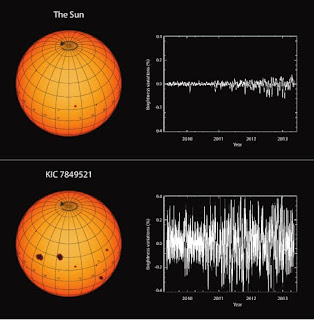The sun appears to be far less active than similar stars in terms of brightness variations caused by sunspots and other phenomena – a “boring” personality, according to scientists, that may not be a bad thing for us Earthlings.
By cosmic standards the sun is extraordinarily monotonous. This is the result of a study presented by researchers from the Max Planck Institute for Solar System Research in the upcoming issue of Science. For the first time, the scientists compared the sun with hundreds of other stars with similar rotation periods. Most displayed much stronger variations. This raises the question whether the sun has been going through an unusually quiet phase for several millennia.
After examining 369 other stars similar to the sun (size, surface temperatures, and rotation period), researchers came to a conclusion on thursday that on an average, they shine five times more brightly in comparison to the sun. It takes the sun 24½ days to rotate once on its axis.
The lead author of the research published in the journal Science, Astronomer Timo Reinhold from Max Planck Institute for Solar System Research in Germany, said “This variability is caused by dark spots on the surface of the star rotating in and out of view. A direct measure of solar activity is the number of sunspots on the surface.”
The sun – essentially a hot ball of hydrogen and helium – is an average-sized star that formed more than 4.5 billion years ago and is roughly halfway through its lifespan. Its diameter is about 864,000 miles (1.4 million km). Its surface temperature is about 10,000 degrees Fahrenheit (5,500 degrees Celsius).
The Astronomer continued saying, “Temperature and rotation period are thought to be the major ingredients for the dynamo inside the star, which generates its magnetic field, and eventually the number and size of the spots causing the brightness to vary. Finding such stars with very similar parameters as our sun but being five times more variable was surprising,”
“A much more active sun might have also affected Earth on geological time scales – paleoclimatology. A ‘too active’ star would definitively change the conditions for life on the planet, so living with a quite boring star is not the worst option”.
Satellites, could be tampered with ad Astronauts could be in dager as n increase in magnetic activity associated with sunspots can lead to solar flares, coronal mass ejections – large expulsions of plasma and magnetic field from the outermost part of the sun’s atmosphere – and other electromagnetic phenomena that can affect Earth.
There is, however, no cause for concern. For the foreseeable future, there is no indication of such solar “hyperactivity.” On the contrary: For the last decade, the Sun has been showing itself to be rather weakly active, even by its own low standards. Predictions of activity for the next eleven years indicate that this will not change soon.
